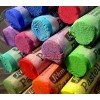Pastels...

Pastel media can be subdivided as follows:
Soft pastels: This is the most widely used form of pastel. The drawing can be readily smudged and blended, but it results in a higher proportion of dust. Finished drawings made with soft pastels require protecting, either framing under glass or spraying with a fixative to prevent smudging; hairspray also works, although caution should be taken, as fixatives may affect the colour or texture of the drawing. White chalk may be used as a filler in producing pale and bright hues with greater luminosity.
Pan Pastels: These are formulated with a minimum of binder in flat compacts (similar to some makeup) and applied with special Soft micropore sponge tools. No liquid is involved. A 21st-century invention, Pan Pastels can be used for the entire painting or in combination with soft and hard sticks.
Hard pastels: These have a higher portion of binder and less pigment, producing a sharp drawing material that is useful for fine details. These can be used with other pastels for drawing outlines and adding accents. Hard pastels are traditionally used to create the preliminary sketching out of a composition. However, the colours are less brilliant and are available in a restricted range in contrast to soft pastels.
Pastel pencils: These are pencils with a pastel lead. They are useful for adding fine details.
Oil pastels: These have a soft, buttery consistency and intense colours. They are dense and fill the grain of paper and are slightly more difficult to blend than soft pastels, but do not require a fixative. They may be spread across the work surface by thinning with turpentine.
Water-soluble pastels: These are similar to soft pastels, but contain a water-soluble component, such as Polyethylene glycol. This allows the colours to be thinned out to an even, semi-transparent consistency using a water wash. Water-soluble pastels are made in a restricted range of hues in strong colours. They have the advantages of enabling easy blending and mixing of the hues, given their fluidity, as well as allowing a range of colour tint effects depending upon the amount of water applied with a brush to the working surface.
https://en.wikipedia.org/wiki/Pastel
